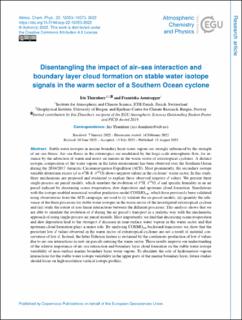| dc.contributor.author | Thurnherr, Iris Livia | |
| dc.contributor.author | Aemisegger, Franziska | |
| dc.date.accessioned | 2023-03-08T13:33:20Z | |
| dc.date.available | 2023-03-08T13:33:20Z | |
| dc.date.created | 2022-11-08T15:15:09Z | |
| dc.date.issued | 2022 | |
| dc.identifier.issn | 1680-7316 | |
| dc.identifier.uri | https://hdl.handle.net/11250/3057111 | |
| dc.description.abstract | Stable water isotopes in marine boundary layer water vapour are strongly influenced by the strength of air–sea fluxes. Air–sea fluxes in the extratropics are modulated by the large-scale atmospheric flow, for instance by the advection of warm and moist air masses in the warm sector of extratropical cyclones. A distinct isotopic composition of the water vapour in the latter environment has been observed over the Southern Ocean during the 2016/2017 Antarctic Circumnavigation Expedition (ACE). Most prominently, the secondary isotope variable deuterium excess (d=δ2H–8⋅δ18O) shows negative values in the cyclones’ warm sector. In this study, three mechanisms are proposed and evaluated to explain these observed negative d values. We present three single-process air parcel models, which simulate the evolution of δ2H, δ18O, d and specific humidity in an air parcel induced by decreasing ocean evaporation, dew deposition and upstream cloud formation. Simulations with the isotope-enabled numerical weather prediction model COSMOiso, which have previously been validated using observations from the ACE campaign, are used to (i) validate the air parcel models, (ii) quantify the relevance of the three processes for stable water isotopes in the warm sector of the investigated extratropical cyclone and (iii) study the extent of non-linear interactions between the different processes. This analysis shows that we are able to simulate the evolution of d during the air parcel's transport in a realistic way with the mechanistic approach of using single-process air parcel models. Most importantly, we find that decreasing ocean evaporation and dew deposition lead to the strongest d decrease in near-surface water vapour in the warm sector and that upstream cloud formation plays a minor role. By analysing COSMOiso backward trajectories we show that the persistent low d values observed in the warm sector of extratropical cyclones are not a result of material conservation of low d. Instead, the latter Eulerian feature is sustained by the continuous production of low d values due to air–sea interactions in new air parcels entering the warm sector. These results improve our understanding of the relative importance of air–sea interaction and boundary layer cloud formation on the stable water isotope variability of near-surface marine boundary layer water vapour. To elucidate the role of hydrometeor–vapour interactions for the stable water isotope variability in the upper parts of the marine boundary layer, future studies should focus on high-resolution vertical isotope profiles. | en_US |
| dc.language.iso | eng | en_US |
| dc.publisher | Copernicus Publications | en_US |
| dc.rights | Navngivelse 4.0 Internasjonal | * |
| dc.rights.uri | http://creativecommons.org/licenses/by/4.0/deed.no | * |
| dc.title | Disentangling the impact of air-sea interaction and boundary layer cloud formation on stable water isotope signals in the warm sector of a Southern Ocean cyclone | en_US |
| dc.type | Journal article | en_US |
| dc.type | Peer reviewed | en_US |
| dc.description.version | publishedVersion | en_US |
| dc.rights.holder | Copyright 2022 The Author(s) | en_US |
| cristin.ispublished | true | |
| cristin.fulltext | original | |
| cristin.qualitycode | 2 | |
| dc.identifier.doi | 10.5194/acp-22-10353-2022 | |
| dc.identifier.cristin | 2070746 | |
| dc.source.journal | Atmospheric Chemistry and Physics (ACP) | en_US |
| dc.source.pagenumber | 10353-10373 | en_US |
| dc.identifier.citation | Atmospheric Chemistry and Physics (ACP). 2022, 22 (15), 10353-10373. | en_US |
| dc.source.volume | 22 | en_US |
| dc.source.issue | 15 | en_US |

